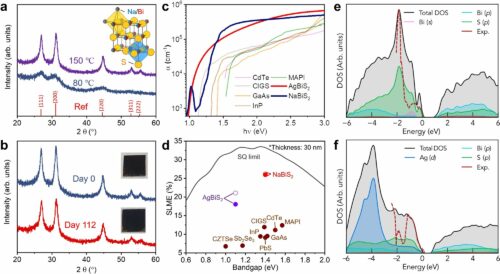Researchers from Cambridge, in collaboration led by Imperial College London have developed a material that can absorb sunlight similar to the conventional silicon solar cells with 10,000 times lower thickness.

The researchers used bismuth sulfide (NaBiS2) grown on nanocrystals deposited from solution to make films of 30 nanometers thickness. NaBiS2 has nontoxic elements that are abundant in the earth’s crust. The researchers have also found that these materials have an unusual effect on transport of photogenerated charges. The team used spectroscopic techniques to study these properties.
The inhomogeneous distribution of sodium and bismuth ions forms localised electronic states. These localised electronic states capture charges rapidly. These charges live in this state for tens of microseconds, which is 100 times longer than the other conventional semiconductors. However, their ability to move and extract electricity is limited as these charges are trapped and can only hop between states.
The researchers have also found that the atomic defects play a very minor role in NaBiS2 as the transportation of charges is dominated by the effects of the localised states. These results demonstrate the importance of understanding the influence on the electronic states and controlling the degree of disorder.
Also, the NaBiS2 can be stable in air for the entire duration of the test, 11 month without any encapsulation. However, other photovoltaic materials are not stable for this long time. This proves the long-term durability of the material, making it the best fit for commercial solar cells.
Dr. Robert Hoye, corresponding author on the paper and Senior Lecturer in the Department of Materials at Imperial College London commented that “these are very exciting results that open up new avenues to optimise the properties of solar energy harvesters. NaBiS2 belongs to an intriguing family of materials, and we hope that the new insights generated in our work will guide the discovery and selection of a new generation of efficient and cost-effective photoactive compounds.”









Thank you Dr. Robert Hoye for that very good news especially here in the Philippines our electric here is very expensive.if that is the case I planning NOW to used Solar base to news about NaBiS2.I hope and pray will release very very soon.more power to you,and always stay safe.Godbless.